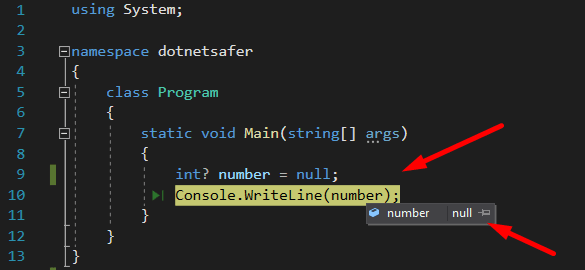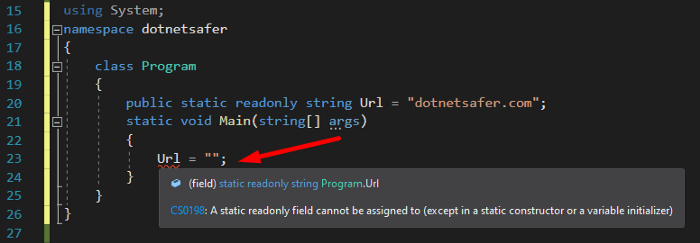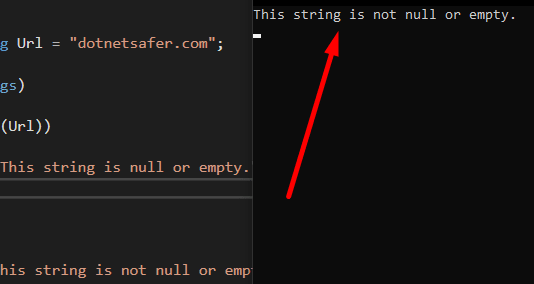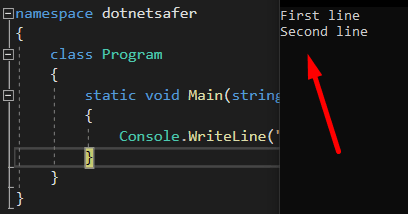If you have taken a call to grow your career in the information technology sector, knowledge of coding is essential. It is the most in-demand skill in the industry. Thus, the programming knowledge you gain and practice, in the beginning, is priceless.
Here are 5 good C# tips that will be of great help to you🤗
1. Nullable number
This tip is based on knowing that numbers CAN accept nulls. This tip is strange for many developers of other languages because we will use the symbol ? after the data type.
In this case we will use int but first let’s see what it would look like without the symbol ? 👇
using System;
namespace bytehide
{
class Program
{
static void Main(string[] args)
{
int number = null;
Console.WriteLine(number);
}
}
}
If we simply copy and paste this code, when executed it generates an error as you can see in the following image 👇
Now we will simply add the symbol ? to int to look like int? .
Let’s see how the code would look like 👇
using System;
namespace bytehide
{
class Program
{
static void Main(string[] args)
{
int? number = null;
Console.WriteLine(number);
}
}
}
Now let’s run it again and see what happens 👇
Good! It has worked, it has not returned any error and if we check the value of number we can indeed see that yes, it is null.
2. Readonly value
In a field statement, readonly indicates that the assignment to a field can only occur as part of the declaration or in a constructor of the same class. That is, READ ONLY.
Based on this, let’s see how it works with this example 👇
using System;
namespace bytehide
{
class Program
{
public static readonly string Url = "bytehide.com";
}
}
Here we can simply see that the Url value is “bytehide.com”.
But… what if we try to change it later, is it possible? Let’s find out 👇
using System;
namespace bytehide
{
class Program
{
public static readonly string Url = "bytehide.com";
static void Main(string[] args)
{
Url = "";
}
}
}
We tried to change the Url value to null and no, it didn’t let us 👇
An example of use of readonly is in the connection to a database since it is always the same and we are not interested that nobody can change it.
3. Detect null strings
In this tip we are going to see how we can detect if a string is null or not null. For this we are going to reuse the example of the previous tip 👇
using System;
namespace bytehide
{
class Program
{
public static readonly string Url = "bytehide.com";
static void Main(string[] args)
}
}
Now we are going to use sting.IsNullOrEmpty. This checks strings for references to null or empty strings. We simply return in console if it is null or not null 👇
using System;
namespace bytehide
{
class Program
{
public static readonly string Url = "bytehide.com";
static void Main(string[] args)
{
if (string.IsNullOrEmpty(Url))
Console.WriteLine ("This string is null or empty.");
else
Console.WriteLine("This string is not null or empty.");
}
}
}
And if we execute we can see that it returns that it is not empty (as its value is “bytehide.com”) 👇
4. Terminate application
Here we are going to see a very simple way for the application to exit its execution when a condition is met. Let’s see the example that we are going to use 👇
using System;
namespace bytehide
{
class Program
{
static void Main(string[] args)
{
int number = 1;
if (number == 1)
{
Console.WriteLine("Exit");
}
Console.WriteLine("No exit");
}
}
}
At this point I want that when the condition is met (which is met), the application exits its execution. So we will use Environment.FailFast and exit with the indicated argument: “Successfully exited” 👇
using System;
namespace bytehide
{
class Program
{
static void Main(string[] args)
{
int number = 1;
if (number == 1)
{
Console.WriteLine("Exit");
Environment.FailFast("Successfully exited");
}
Console.WriteLine("No exit");
}
}
}
When running it, we can indeed see that the application exits its execution correctly.
5. Line break
Who is not accustomed to making line breaks with /n ? 🤔
Well, in C# there is a special way to make them. For it, inside the environment class we have NewLine 👇
using System;
namespace bytehide
{
class Program
{
static void Main(string[] args)
{
Console.WriteLine($"First{Environment.NewLine}Second");
}
}
}
With this we will have a line break. Let’s run to check it 👇
These have been 5 basic tips. I NEED YOU to comment me WHAT LEVEL you want the following (COMMENT me with EMOJI):
🟢 Basic level
🟠 Intermediate Level
🔴 Advanced Level
The emoji that is repeated the most, wins!













Top comments (3)
It is great to see people writing about C#, but your article is missing crucial information.
Environment.FailFast()is for a very specific use-case and in general one should instead useEnvironment.Exit()to exit an application.FailFast()is meant to be used when the process encounters a catastrophic error, such as one where external data could be destroyed. When the method is used, not only does it log an error with the OS, generate a memory dump, and try to send information to Microsoft, it also skips any activefinallyblocks and doesn't call any exit events. No one wants their application to panic, memory dump, and phone Microsoft every time it closes, so please useExit()and notFailFast()to exit applications.Also, it is great that you mentioned
Environment.NewLine, but it is misleading to not explicitly point out thatEnvironment.NewLineis a\non Linux and\r\non Windows as its purpose is to abstract over the OS differences of newline characters.I would’ve loved to see you expand a bit more on your first point. What exactly happens when you add a question mark to the type? When would you opt to do this and what are the implications? Is it even the same type? (it is in fact fascinating)
Best